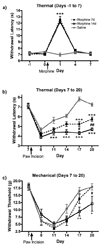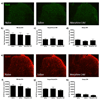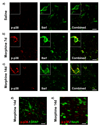Morphine tolerance attenuates the resolution of postoperative pain and enhances spinal microglial p38 and extracellular receptor kinase phosphorylation
- PMID: 20493931
- PMCID: PMC2904400
- DOI: 10.1016/j.neuroscience.2010.05.030
Morphine tolerance attenuates the resolution of postoperative pain and enhances spinal microglial p38 and extracellular receptor kinase phosphorylation
Abstract
Persistent postoperative pain is a very common phenomenon which severely affects the lives of patients who develop it following common surgical procedures. Opioid analgesics are of limited efficacy in the treatment of persistent pain states because of side effects including antinociceptive tolerance. We have previously shown that surgical incision injury and morphine tolerance share similar mechanisms, including a CNS role of spinal cord glia. We therefore hypothesized that prior chronic morphine exposure would inhibit the resolution of postoperative allodynia through increased glial ionized calcium-binding adaptor protein 1 (Iba1) and glial fibrillary acidic protein (GFAP) protein expression and mitogen activated protein kinase (MAPK) activation. To test this hypothesis, rats were implanted with s.c. osmotic minipumps on day zero, releasing saline or morphine for 7 days preceding or 7 days preceding and following paw incision surgery, which was completed on day seven. Thermal hyperalgesia and mechanical allodynia were assessed postoperatively every 3 days. Chronic morphine attenuated the resolution of postoperative thermal hyperalgesia and mechanical allodynia through day 20. However, no changes in Iba1 or GFAP expression were observed in the spinal cord dorsal horn between groups. Assessment of MAPK protein phosphorylation revealed that chronic morphine administration enhanced both p38 and extracellular receptor kinase (pERK) phosphorylation compared to saline on day 20. p-p38 and pERK immunofluorescence were only observed to colocalize with a marker of microglial cells and not with markers of astrocytes or neurons. Together, these data demonstrate that chronic morphine administration attenuates the resolution of postoperative allodynia in association with microglial p38 and extracellular receptor kinase (ERK) phosphorylation, independent of changes in Iba1 and GFAP expression.
Copyright (c) 2010 IBRO. Published by Elsevier Ltd. All rights reserved.
Conflict of interest statement
The authors report no conflicts of interest for the studies presented herein.
Figures









Similar articles
-
Evidence for a role of endocannabinoids, astrocytes and p38 phosphorylation in the resolution of postoperative pain.PLoS One. 2010 May 28;5(5):e10891. doi: 10.1371/journal.pone.0010891. PLoS One. 2010. PMID: 20531936 Free PMC article.
-
Inhibition of microglial P2X4 receptors attenuates morphine tolerance, Iba1, GFAP and mu opioid receptor protein expression while enhancing perivascular microglial ED2.Pain. 2010 Sep;150(3):401-413. doi: 10.1016/j.pain.2010.02.042. Epub 2010 Jun 22. Pain. 2010. PMID: 20573450 Free PMC article.
-
Tissue plasminogen activator contributes to morphine tolerance and induces mechanical allodynia via astrocytic IL-1β and ERK signaling in the spinal cord of mice.Neuroscience. 2013 Sep 5;247:376-85. doi: 10.1016/j.neuroscience.2013.05.018. Epub 2013 May 21. Neuroscience. 2013. PMID: 23707980 Free PMC article.
-
Intraoperative electroacupuncture relieves remifentanil-induced postoperative hyperalgesia via inhibiting spinal glial activation in rats.Mol Pain. 2017 Jan-Dec;13:1744806917725636. doi: 10.1177/1744806917725636. Mol Pain. 2017. PMID: 28825338 Free PMC article.
-
Microglia: a promising target for treating neuropathic and postoperative pain, and morphine tolerance.J Formos Med Assoc. 2011 Aug;110(8):487-94. doi: 10.1016/S0929-6646(11)60074-0. J Formos Med Assoc. 2011. PMID: 21783017 Free PMC article. Review.
Cited by
-
μ Opioid Receptor-Triggered Notch-1 Activation Contributes to Morphine Tolerance: Role of Neuron-Glia Communication.Mol Neurobiol. 2020 Jan;57(1):331-345. doi: 10.1007/s12035-019-01706-6. Epub 2019 Jul 25. Mol Neurobiol. 2020. PMID: 31347026
-
Microglia in Pain: Detrimental and Protective Roles in Pathogenesis and Resolution of Pain.Neuron. 2018 Dec 19;100(6):1292-1311. doi: 10.1016/j.neuron.2018.11.009. Neuron. 2018. PMID: 30571942 Free PMC article. Review.
-
Exploring the neuroimmunopharmacology of opioids: an integrative review of mechanisms of central immune signaling and their implications for opioid analgesia.Pharmacol Rev. 2011 Sep;63(3):772-810. doi: 10.1124/pr.110.004135. Epub 2011 Jul 13. Pharmacol Rev. 2011. PMID: 21752874 Free PMC article. Review.
-
Change in functional selectivity of morphine with the development of antinociceptive tolerance.Br J Pharmacol. 2015 Jan;172(2):549-61. doi: 10.1111/bph.12703. Epub 2014 Jul 1. Br J Pharmacol. 2015. PMID: 24666417 Free PMC article.
-
Increased clearance of morphine in sickle cell disease: implications for pain management.J Pain. 2011 May;12(5):531-8. doi: 10.1016/j.jpain.2010.10.012. Epub 2011 Feb 1. J Pain. 2011. PMID: 21277838 Free PMC article.
References
-
- Almela P, Garcia-Nogales P, Romero A, Milanes MV, Laorden ML, Puig MM. Effects of chronic inflammation and morphine tolerance on the expression of phospho-ERK ½ and phospho-P38 in the injured tissue. Naunyn Schmiedebergs Arch Pharmacol. 2009;379:315–323. - PubMed
-
- Brennan TJ, Vandermeulen EP, Gebhart GF. Characterization of a rat model of incisional pain. Pain. 1996;64:493–501. - PubMed
-
- Chaplan SR, Bach FW, Pogrel JW, Chung JM, Yaksh TL. Quantitative assessment of tactile allodynia in the rat paw. J Neurosci Methods. 1994;53:55–63. - PubMed
-
- Chen Y, Sommer C. The role of mitogen-activated protein kinase (MAPK) in morphine tolerance and dependence. Mol Neurobiol. 2009;40:101–107. - PubMed
-
- Colburn RW, DeLeo JA, Rickman AJ, Yeager MP, Kwon P, Hickey WF. Dissociation of microglial activation and neuropathic pain behaviors following peripheral nerve injury in the rat. J Neuroimmunol. 1997;79:163–175. - PubMed
Publication types
MeSH terms
Substances
Grants and funding
LinkOut - more resources
Full Text Sources
Research Materials
Miscellaneous

